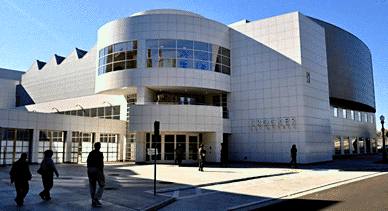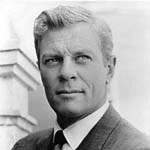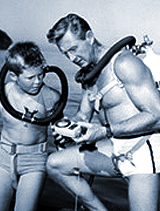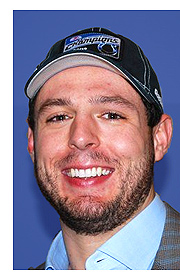Bruce liked animals, games, martial arts, music, entertainment, and public policy, but he was first and foremost a voracious reader — went cover to cover through the Holy Bible at the age of nine, and figured he had read through it again at least ten more times. Beginning as a child, he consumed three to five books a week through much of his life. It was only natural that he would devote himself to writing. Keeping in mind his great love for dogs, here is something penned by his alter ego, Elbo C. Buckminster:
“I agree with whiners, of the last few generations at least, that life is a bitch. But I’m not whining when I say it. Maybe the first person to utter that phrase was misunderstood, maybe wasn’t whining either, maybe, as I, realized that the spark of physical in this plane is protected by Nature, the bitch-goddess, sharp-toothed and warm-teated. And, like any bitch, when her offspring are threatened, Nature doesn’t retreat. She bare her teeth, she threatens, she snarls — and she bites. She won’t give up, no matter how overmatched, until the threat leaves or until she is torn to bloody shreds. So count on Life, your bitch-mother, for she’ll not abandon you easily. But respect her. If you misbehave, she may snap your little puppy head off.”
As most of you know, Bruce lost his solitary kidney in his mid 20s and spent 71 months on hemodialysis before gaining a transplanted organ, which would serve him for eight years, until he lost it while battling the devastating inflammation of his pancreas that left him gravely ill, hospitalized, and clinging to life for nearly a year, during much of which he could take no food or water by mouth. By his own account, “I died a few times — three or four, I don’t know — and at least once they were ready to call the time of my death, but one of the ICU nurses refused to give up on me; I guess she felt I still has some fight in me, and she was right.”
Indeed. When he was finally released to tenuous home care, we were told that he was only the second patient in the 100-plus-year history of that Indianapolis medical center to survive such a severe pancreatic hemorrhage. We never learned anything about that other person, but we came to know a Kentucky man named Nathaniel who defied similar odds at UK Medical Center well below one percent, and he helped us preserve hope during Bruce’s darkest days. That was 2005. But even more significant to us than Nathaniel’s kindness — and, of course, the support and encouragement of so many friends and family — was Bruce’s own valiant, grinding effort to meet daily challenges more daunting than it seemed any human being should have to face.
Later (this was 2006, April), to a standing-room-only group of us who met on Sundays to share silence, in perhaps the most awesome extemporaneous public commentary I’ve heard — one of those powerfully unique, you-had-to-be-there moments — Bruce told us that he made it through those grueling months by virtue of what might be understood, as he put it, “lying fallow,” a spontaneous, involuntary suppression of normal cognitive and emotional activity, and I have no reason to doubt it, since he retained only a partial memory of the ordeal. There were times he was so fragile that the doctors could give him no pain medication, even after major surgery. Dana and I will always remember that during the worst of his pain, he told us that he was able to endure it by reminding himself that Christ had suffered even more. Any faith in the future we managed to keep was inspired by this, Bruce’s own profound inner focus and his refusal to quit. Bruce wrote:
“Perhaps this is what Jesus meant when he said, ‘if you but had the faith of a mustard seed’—not belief, but faith. Faith doesn’t require belief, but a deeper knowledge, an intuitive awareness of possibility, even a denial of reality. Faith flies in the face of truth. So while I feel in my bones the existence of a being we, in our ignorance, call God, and the existence of an energy level beyond this lowly one of rock, flesh, and death, I refuse to qualify, quantify, or classify it, because to do so takes me further from the truth, not nearer.”
At long last, he was discharged to confront what he knew to be a difficult three-to-five-year recovery at best, with more surgeries and a relentless cycle of dialysis. Family and friends— that was five years ago. In fact, he went home after that first long hospitalization on Christmas Eve, and that was exactly five years ago this past Christmas Eve. Bruce had completed that journey of recovery, had made a transition, with his mother’s help, to a new, less debilitating method of in-home care, and was optimistic about his chances for another transplant, with a return to school to fulfill his original goal of becoming an English teacher. And then, after all that, the earthly saga of Bruce Joel Willoughby came to a close — when his soul abruptly flew from a physical organism compromised by so many years of precarious health.
We are here to comfort each other in sorrow, but more importantly, to celebrate Bruce’s life, to be inspired by it, as I have been, and to accept that some things can never be understood on this side of the curtain. It brings us once again to the words of Cockburn, who Bruce admired most as a musician and songwriter (and it went well beyond their sharing the name of Bruce):
An elegant song won’t hold up long
When the palace falls and the parlor’s gone.
We all must leave, but it’s not the end.
We’ll meet again at the festival of friends.
Smiles and laughter and pleasant times—
There’s love in the world, but it’s hard to find.
I’m so glad I found you; I’d just like to extend
An invitation to the festival of friends.
Some of us live and some of us die.
Someday God’s going to tell us why.
Open your heart and grow with what life sends.
That’s your ticket to the festival of friends.
Like an imitation of a good thing past,
These days of darkness surely will not last.
Jesus was here, and he’s coming again
To lead us to his festival of friends.
Bruce was troubled in body, but strong in spirit. One didn’t have the sense that he was in decline, but quietly fighting toward a crest, ever determined, never in retreat, but slowly gaining ground, inch-by-inch against insurmountable odds. Always the chess player, he would find a way to extend the end game one more move, one more cunning evasion against near-certain checkmate, yet unafraid of passing, if a stalemate was declared. I doubt if there was anyone except his mother who really understood how hard he tried, including me, but I never lost sight of how incredibly remarkable he was among everyone I’ve ever known. There were times when it seemed he held intact his presence here by sheer force of will. For me, he always will be the true “Impossible Missions Force of Nature.”
It is fitting that we close with Bruce’s re-creation of his summation from those memorable words he delivered in April of 2006, which he titled, “HAH! MISSED ME AGAIN.”
“I leave you with this thought: If you have unfinished business in your life, get to it. Be it mending relationships, expressing yourself creatively, getting involved in community service, going for your dream job, returning to school, or losing weight — get to it. You may not be rewarded with a better economic life, or a longer life, or a happier life, but I guarantee you will be rewarded with a worthwhile life, a satisfactory life, whether it end tomorrow or ninety years hence.”





















 And then, when Bruce was gravely ill and we spent a good portion of a year hanging out around Indianapolis, I began to favor the Colts. The clincher took place last year, when I worked professionally with local star Jacob T, a second-year back-up tight end and special team starter for the team, following his brilliant career at the University of Kentucky. After that I was hooked on Indy, deriving much pleasure from watching their “almost-perfect” season and playoff success. Nevertheless, despite my desire to see Jacob be part of a Super Bowl victory, I’m not sad that the Colts fell short against the Saints tonight, because my heart is with Kristi and the Hornsby family as they enjoy a wonderful celebration in New Orleans.
And then, when Bruce was gravely ill and we spent a good portion of a year hanging out around Indianapolis, I began to favor the Colts. The clincher took place last year, when I worked professionally with local star Jacob T, a second-year back-up tight end and special team starter for the team, following his brilliant career at the University of Kentucky. After that I was hooked on Indy, deriving much pleasure from watching their “almost-perfect” season and playoff success. Nevertheless, despite my desire to see Jacob be part of a Super Bowl victory, I’m not sad that the Colts fell short against the Saints tonight, because my heart is with Kristi and the Hornsby family as they enjoy a wonderful celebration in New Orleans.